Text
We've been hard at work developing @forevergoldgame! So excited to start sharing snippets of what we've cooked up so far. I've colored so many little heads. This is only a fraction of what we've crafted in portraits alone. ;)

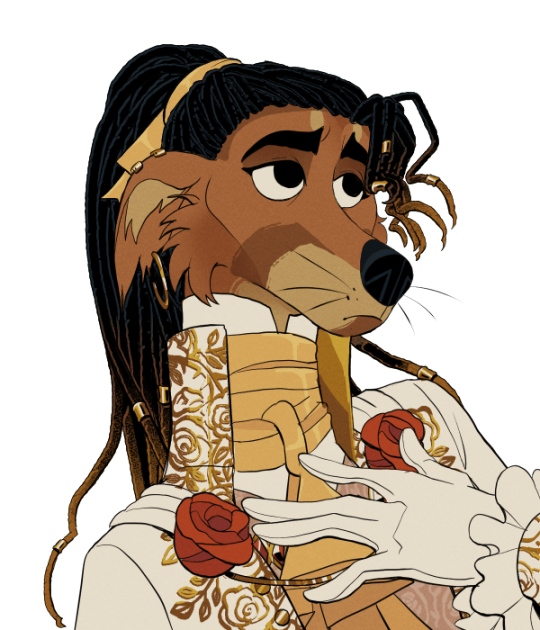
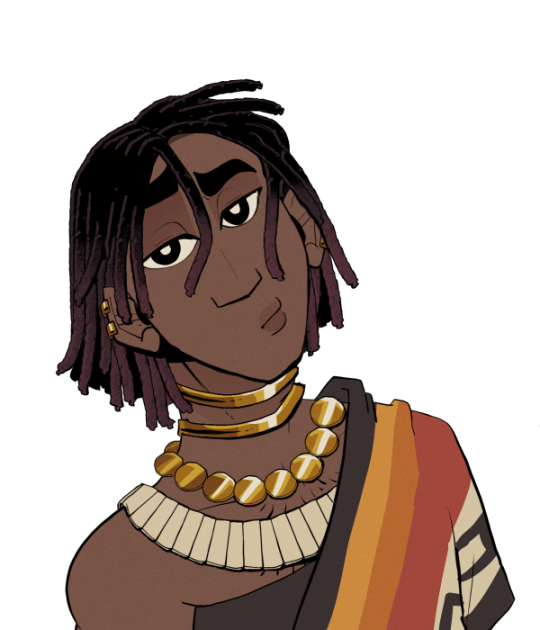



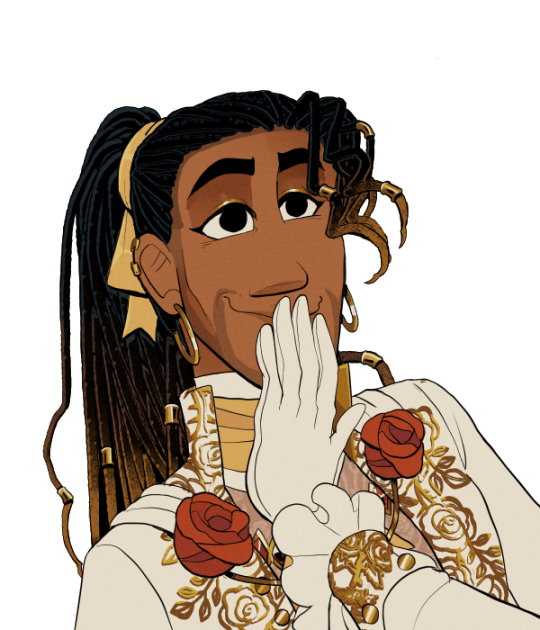
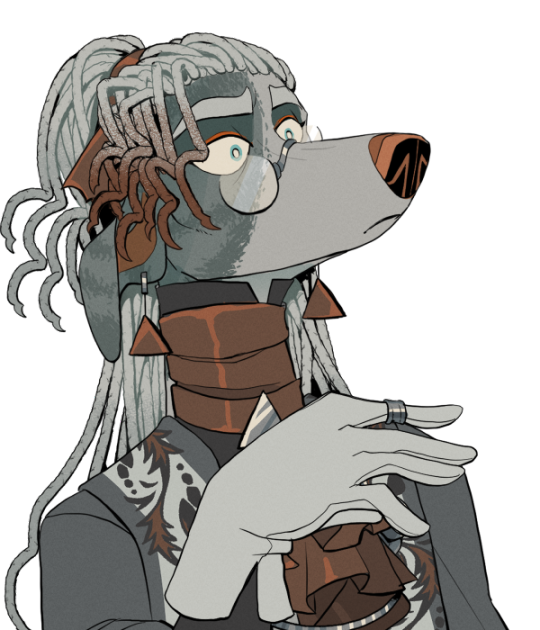

Small assortment of portrait sprites from Forever Gold. Seeing it all "in-engine" has me giddy.
(These were colored by @lsdoiphin ... we gotta split the work!)
#verse: forever gold#collab#look at all our beautiful heads#oc: kaitos#guest oc: lucas#guest oc: quincy#guest oc: imani#guest oc: d'angelo#guest oc: oscar
112 notes
·
View notes
Text

for @lsdoiphin
69 notes
·
View notes
Text

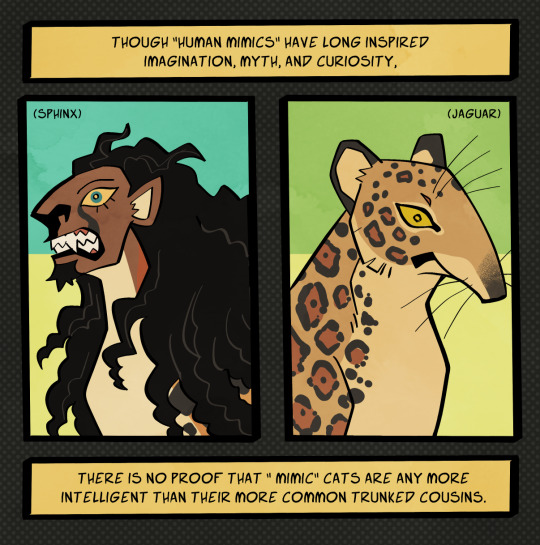
Sphinxes are crafty the same way that coyotes or bears are crafty. Their cleverness shouldn't be underestimated, yes, but they're not going to win any battles of wits against something like a corvid or a parrot.
#answered ask#verse: forever gold#sphinx#fantasy animal#worldbuilding#creature design#monster design
148 notes
·
View notes
Text


In public, yes.
In her private life, absolutely not. She had many doubts about the arrangement, some of which had nothing to do with Alexander (now King-Regent Andimeur) as a person.
In fact, Ancha found it difficult to have much of an opinion about Alexander as an individual at all. Since Amalthea and Alexander married at a young age (both about 18), she struggled to conceptualize him as a whole human man. Placing judgment upon his person when he was hardly older than a boy and thrust onto the throne at short notice felt... unfair.
Of course, it has been a good 27 or so years since then (and over a decade since Amalthea's death). In that time, Ancha has come to realize that Alexander is... well, kind of grating.
#whew it's been a while since I posted#because all my energy is going towards actually working on Forever Gold#answered ask#oc ask#oc: ancha#verse: forever gold#character ask#if you remember Alexander looking different in Danny's art it's because she asked that I redesign him#oc: alexander#fantasy setting#royalty
21 notes
·
View notes
Text



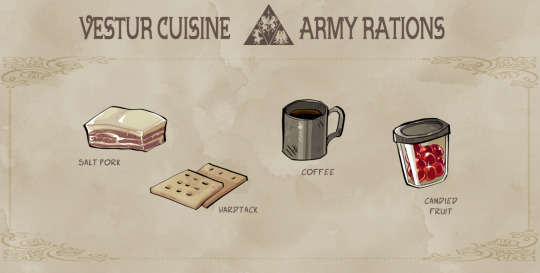
Foods of Vestur
@broncoburro and @chocodile provoked me into doing some illustrated worldbuilding for Forever Gold ( @forevergoldgame ), an endeavor I was happy to undertake. Unbeknownst to me, it would take the better part of a week to draw.
In the process, I conjured about an essay's worth of fantasy food worldbuilding, but I'm going to try and keep things digestible (pardon my pun). Lore under the cut:
The Middle Kingdom
The Middle Kingdom has ample land, and its soil, landscapes, and temperate climate are amenable to growing a variety of crops and raising large quantities of livestock. The Midland palate prefers fresh ingredients with minimal seasoning; if a dish requires a strong taste, a cook is more likely to reach for a sharp cheese than they are to open their spice drawer. Detractors of Middle Kingdom cuisine describe it as bland, but its flavor relies on the quality of its components more than anything.
KEY CROPS: wheat, potatoes, carrots, green beans, apples, pears, and grapes
KEY LIVESTOCK: Midland goats, fowl, and hogs
ROAST FOWL: Cheap and easy to raise, fowl is eaten all over Vestur and by all classes. Roasted whole birds are common throughout, but the Middle Kingdom's approach to preparation is notable for their squeamish insistence on removing the head and neck before roasting, even among poorer families. Fowl is usually roasted on a bed of root vegetables and shallots and served alongside gravy and green beans.
GOAT RIBEYE: Vestur does not have cattle – instead it has a widely diversified array of goats, the most prominent being the Middle Kingdom's own Midland goat. The Midland goat is a huge caprid that fills the same niche as cattle, supplying Vestur with meat and dairy products. Chevon from the Midland goat is tender with a texture much like beef, though it retains a gamier, “goat-ier” taste. It is largely eaten by the wealthy, though the tougher and cheaper cuts can be found in the kitchens of the working class. Either way, it is almost always served with gravy. (You may be sensing a pattern already here. Midlanders love their gravy.)
FETTUCCINE WITH CHEESE: Noodles were brought to the Middle Kingdom through trade with the South and gained popularity as a novel alternative to bread. The pasta of Midland Vestur is largely eaten with butter or cream sauce; tomato or pesto sauces are seldom seen.
CHARCUTERIE WITH WINE: Charcuterie is eaten for the joy of flavors rather than to satiate hunger, and therefore it is mainly eaten by the upper class. It is commonly eaten alongside grape wine, a prestigious alcohol uniquely produced by the Middle Kingdom. The flavor of grape wine is said to be more agreeable than the other wines in Vestur, though Southern pineapple wine has its share of defenders.
BREAD WITH JAM AND PRESERVES, TEA SANDWICHES, & ROSETTE CAKE: Breads and pastries are big in the Middle Kingdom. The Middle Kingdom considers itself the world leader in the art of baking. Compared to its neighbors, the baked goods they make are soft, light, and airy and they are proud of it. Cakes in particular are a point of ego and a minor source of mania among nobility; it is a well-established cultural joke that a Middle Kingdom noble cannot suffer his neighbor serving a bigger, taller cake. The cakes at Middle Kingdom parties can reach nauseatingly wasteful and absurdist heights, and there is no sign of this trend relenting any time soon.
CHOWDER, FARMER'S POT PIE, GRIDDLECAKES, EGGS, CURED MEATS: If you have the means to eat at all in the Middle Kingdom, you are probably eating well. Due to the Midland's agricultural strength, even peasant dishes are dense and filling. Eggs and cured meats are abundant, cheaper, and more shelf stable than fresh cuts and provide reprieve from the unending wheat and dairy in the Midland diet.
STEWED APPLES AND PEARS, JAM AND PRESERVES: The Midland grows a number of different fruits, with apples and pears being the most plentiful. In a good year, there will be more fruit than anyone knows what to do with, and so jams and preserves are widely available. Stewed fruit has also gained popularity, especially since trade with the Southern Kingdom ensures a stable supply of sugar and cinnamon.
NORTHERN KINGDOM - SETTLED
The Northern Kingdom is a harsh and unforgiving land. Historically, its peoples lived a nomadic life, but since the unification of the Tri-Kingdom more and more of the Northern population have opted to live a settled life. The “settled North” leads a hard life trying to make agriculture work on the tundra, but it is possible with the help of green meur. The Northern palate leans heavily on preserved and fermented foods as well as the heat from the native tundra peppers. Outsiders often have a hard time stomaching the salt, tang, and spice of Northern cuisine and it is widely considered “scary.”
KEY CROPS: potatoes, beets, carrots, tundra pepper
KEY LIVESTOCK: wooly goats, hares*
GOAT POT ROAST: Life up north is hard work and there is much to be done in a day. Thus, slow cooked one-pot meals that simmer throughout the day are quite common.
VENISON WITH PICKLES: Game meat appears in Northern dishes about as much as farmed meat – or sometimes even more, depending on the location. Even “classier” Northern dishes will sometimes choose game meat over domesticated, as is the case with the beloved venison with pickles. Cuts of brined venison are spread over a bed of butter-fried potato slices and potent, spicy pickled peppers and onions. The potatoes are meant to cut some of the saltiness of the dish, but... most foreigners just say it tastes like salt, vinegar, and burning.
MINER STEW: While outsiders often have a hard time distinguishing miner stew from the multitude of beet-tinged stews and pot roasts, the taste difference is unmistakable. Miner's stew is a poverty meal consisting of pickles and salt pork and whatever else is might be edible and available. The end result is a sad bowl of scraps that tastes like salt and reeks of vinegar. The popular myth is that the dish got its name because the Northern poor began putting actual rocks in it to fill out the meal, which... probably never happened, but facts aren't going to stop people from repeating punchy myths.
RYE TOAST WITH ONION JAM: Rye is hardier than wheat, and so rye bread is the most common variety in the North. Compared to Midland bread, Northern bread is dense and gritty. It is less likely to be enjoyed on its own than Midland bread, both because of its composition and because there's less to put on it. Unless you've the money to import fruit spreads from further south, you're stuck with Northern jams such as onion or pepper jam. Both have their appreciators, but bear little resemblance to the fruit and berry preserves available elsewhere in Vestur.
HARE DAIRY: Eating hare meat is prohibited in polite society due to its association with the haretouched and heretical nomadic folk religions, but hare dairy is fair game. Hare cheese ranges from black to plum in color, is strangely odorless, and has a pungent flavor akin to a strong blue cheese. It is the least contentious of hare milk products. Hare milk, on the other hand, is mildly toxic. If one is not acclimated to hare milk, drinking it will likely make them “milk sick” and induce vomiting. It is rarely drunk raw, and is instead fermented into an alcoholic drink similar to kumis.
MAPLE HARES AND NOMAD CANDY: Maple syrup is essentially the only local sweetener available in the North, and so it is the primary flavor of every Northern dessert. Simple maple candies are the most common type of sweet, though candied tundra peppers – known as “nomad candy” – is quite popular as well. (Despite its name, nomad candy is an invention of the settled North and was never made by nomads.)
TUNSUKH: Tunsukh is one of the few traditions from the nomadic era still widely (and openly) practiced among Northern nobility. It is a ceremonial dinner meant as a test of strength and endurance between political leaders: a brutally spiced multi-course meal, with each course being more painful than the last. Whoever finishes the dinner with a stoic, tear-streaked face triumphs; anyone who cries out in pain or reaches for a glass of milk admits defeat. “Dessert” consists of a bowl of plain, boiled potatoes. After the onslaught of tunsukh, it is sweeter than any cake.
NORTHERN KINGDOM – NOMADIC NORTH
Although the Old Ways are in decline, the nomadic clans still live in the far North beyond any land worth settling. They travel on hareback across the frozen wasteland seeking “meur fonts” - paradoxical bursts of meur that erupt from the ice and provide momentary reprieve from the harsh environment. The taste of nomad food is not well documented.
KEY CROPS: N/A
KEY LIVESTOCK: hares
PEMMICAN: Nomadic life offers few guarantees. With its caloric density and functionally indefinite “shelf life,” pemmican is about as close as one can get.
SEAL, MOOSE: Meat comprises the vast majority of the nomadic diet and is eaten a variety of ways. Depending on the clan, season, and availability of meur fonts, meat may be cooked, smoked, turned to jerky, or eaten raw. Moose and seal are the most common sources of meat, but each comes with its own challenges. Moose are massive, violent creatures and dangerous to take down even with the aid of hares; seals are slippery to hunt and only live along the coasts.
WANDER FOOD, WANDER STEW: When a green meur font appears, a lush jungle springs forth around it. The heat from red meur fonts may melt ice and create opportunities for fishing where there weren't before. Any food obtained from a font is known as “wander food.” Wander food is both familiar and alien; the nomads have lived by fonts long enough to know what is edible and what is not, but they may not know the common names or preparation methods for the food they find. Fish is simple enough to cook, but produce is less predictable. Meur fonts are temporary, and it's not guaranteed that you'll ever find the same produce twice - there is little room to experiment and learn. As a result, a lot of wander food is simply thrown into a pot and boiled into “wander stew,” an indescribable dish which is different each time.
CENVAVESH: When a haretouched person dies, their hare is gripped with the insatiable compulsion to eat its former companion... therefore, it is only proper to return the favor. Barring injury or illness, a bonded hare will almost always outlive its bonded human, and so the death of one's hare is considered a great tragedy among nomads. The haretouched – and anyone they may invite to join them – sits beside the head of their hare as they consume as much of its rib and organ meat as they can. Meanwhile, the rest of the clan processes the remainder of the hare's carcass so that none of it goes to waste. It is a somber affair that is treated with the same gravity as the passing of a human. Cenvavesh is outlawed as a pagan practice in the settled North.
HARE WINE: While fermented hare's milk is already alcoholic, further fermentation turns it into a vivid hallucinogen. This “hare wine” is used in a number of nomad rituals, most notably during coming of age ceremonies. Allegedly, it bestows its drinker with a hare's intuition and keen sense of direction... of course, truth is difficult to distinguish from fiction when it comes to the Old Ways.
SOUTHERN KINGDOM
The Southern Kingdom is mainly comprised of coast, wetland, and ever-shrinking jungle. While the land is mostly unfit for large-scale agriculture, seafood is plentiful and the hot climate is perfect for exorbitant niche crops. What they can't grow, they obtain easily through trade. Southerners have a reputation for eating anything, as well as stealing dishes from other cultures and “ruining” them with their own interpretations.
KEY CROPS: plantains, sweet potato, pineapple, mango, guava, sugarcane
KEY LIVESTOCK: fowl, marsh hogs, seals
GLAZED EEL WITH FRIED PLANTAINS: A very common configuration for Southern food is a glazed meat paired with a fried vegetable. It almost doesn't matter which meat and which vegetable it is – they love their fried food and they love their sweet and salty sauces in the South. Eel is a culturally beloved meat, much to the shock and confusion of visiting Midlanders.
NARWHAL STEW: Narwhal stew is the South's “anything goes” stew. It does not actually contain narwhal meat, as they are extinct (though the upper class may include dolphin meat as a protein) – instead, the name comes from its traditional status as a “forever soup,” as narwhals are associated with the passage of time in Southern culture. Even in the present day, Southern monasteries tend massive, ever-boiling pots of perpetual stew in order to feed the monks and sybils who live there. Narwhal stew has a clear kelp-based broth and usually contains shellfish. Beyond that, its ingredients are extremely varied. Noodles are a popular but recent addition.
FORAGE: The dish known as “forage” is likewise not foraged, or at least, it hasn't been forage-based in a good hundred years at least. Forage is a lot like poke; it's a little bit of everything thrown into a bowl. Common ingredients include fish (raw or cooked), seaweed, fried noodles, marinated egg, and small quantities of fruit.
HOT POT: Hot pot is extremely popular, across class barriers, in both the South proper and its enclave territories. This is due to its extreme flexibility - if it can be cooked in a vat of boiling broth, it will be. Crustaceans and shellfish are common choices for hot pot in the proper South, along with squid, octopus, mushrooms, and greens.
FLATBREAD: The Southern Kingdom doesn't do much baking. The vast majority of breads are fried, unleavened flatbreads, which are usually eaten alongside soups or as wraps. Wraps come in both savory and sweet varieties; savory wraps are usually stuffed with shredded pork and greens while sweet wraps – which are much more expensive – are filled with fruit and seal cheese.
GRILLED SKEWERS, ROAST SWEET POTATO: While a novel concept for Midlanders and Northerners, street food has long been a part of Southern Kingdom culture. You would be hard pressed to find a Southern market that didn't have at least three vendors pushing grilled or fried something or other. Skewers are the most common and come in countless configurations, but roast sweet potatoes are a close second.
CUT FRUIT AND SEAL CHEESE: Fresh fruit is popular in the South, both local and imported. While delicious on its own, Southerners famously pair it with seal cheese. Which leads me to an important topic of discussion I don't have room for anywhere else...
THE SOUTH AND CHEESE: Since the South doesn't have much in the way of dairy farming, cheese is somewhat rare in their cuisine – but it is present. And important. Cheese is the domain of the Church. Common goat dairy imported from the Middle Kingdom is turned to cheese by monks in Southern monasteries and sold to the Southern public, yes, but as you have noticed there is another cheese prominent in the Southern Kingdom diet: seal cheese. Seal cheese is unlike anything else that has ever been called cheese; the closest it can be compared to is mascarpone. It is is a soft, creamy cheese with a mild flavor and an indulgent fat content. It is used almost exclusively as a dessert, though it is only ever mildly sweetened if at all. It is extremely costly and held in high regard; the most religious Southerners regard it as holy. Dairy seals are a very rare animal and raised exclusively in a small number of Cetolist-Cerostian monasteries, where they are tended and milked by the monks. Due to their status as a holy animal, eating seal meat is forbidden. Eating their cheese and rendering their tallow into soap is fine though.
(HEARTLAND SOUTH) SOUTH-STYLE GOAT: The Heartland South is a Southern enclave territory in the Middle Kingdom. Visiting Midland dignitaries oft wrongly assume that because the Heartland South is in Middle Kingdom territory, Heartland Southerners eat the same food they do exactly as they do. They are horrified to find that familiar sounding dishes like “goat with potatoes” are completely and utterly unrecognizable, drenched in unfamiliar sauces and spices and served alongside fruit they've never eaten. Meanwhile, Heartland Southerners firmly believe that they have fixed the Middle Kingdom's boring food.
(BOREAL SOUTH) “TUNSUKH”: If Midlanders are afraid of Heartland Southern food, Northerners are absolutely furious about cuisine from the Boreal South - the most legendarily offensive being the Boreal South's idea of “tunsukh.” Southerners are no stranger to spice, so when Southern traders began interacting with the North, they liked tunsukh! It's just... they thought it needed a little Southern help to become a real meal, you know? A side of seal cheese soothed the burn and made the meal enjoyable. And because the meal was enjoyable, the portion sizes increased. And plain boiled potatoes? Well, those are a little too plain – creamy mashed sweet potato feels like more of a dessert, doesn't it? ...For some reason, Northerners didn't agree, but that's okay. The Boreal South knows they're just embarrassed they didn't think of pairing seal cheese with tunsukh sooner.
ARMY RATIONS
The food eaten by the King's Army is about what you would expect for late 1700s military; salt pork or salt chevon, hard tack, and coffee. The biggest divergence they have is also one of Vestur's biggest points of pride: they have the means to supply their troops with frivolous luxuries like small tins of candied fruit from the Midland. A love of candied fruit is essentially a Vesturian military proto-meme; proof that they serve the greatest Tri-Kingdom on the planet. Don't get between a military man and his candied fruit unless you want a fight.
512 notes
·
View notes
Text

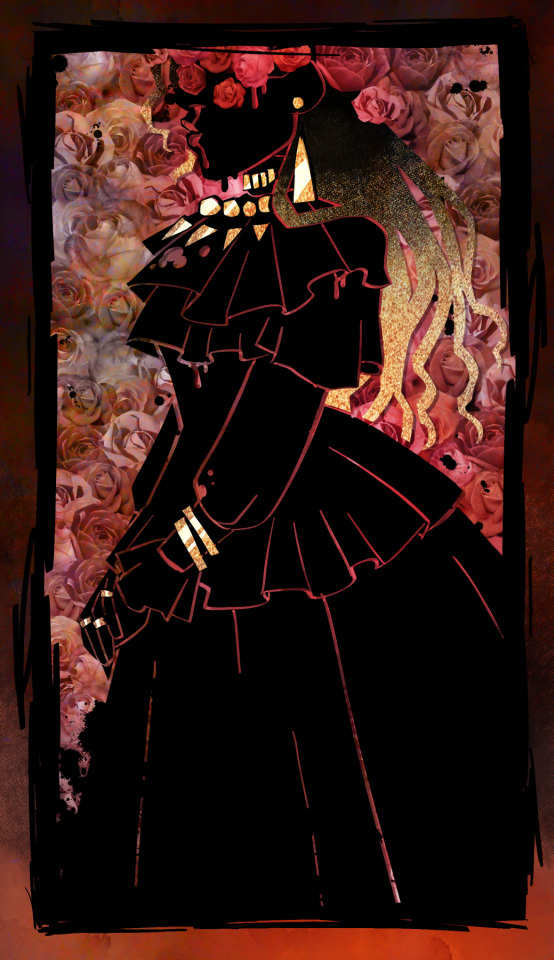
Queen Amalthea died of illness in her early 30s.
The public did not know she was unwell.
33 notes
·
View notes
Text


Inconclusive.
They certainly seem close, but no one is sure how to weigh that against the fact that Cathy has also appeared close with Prince Oscar, and for much longer. Of course, rumor has it that Prince Oscar has appeared close with many other women, so in the end, all we have is conjecture.
#oc: itaja#oc: cathy#verse: forever gold#comic#oc ask#answered ask#fantasy setting#pay no attention to how often Itaja and Cathy vanish together
43 notes
·
View notes
Text



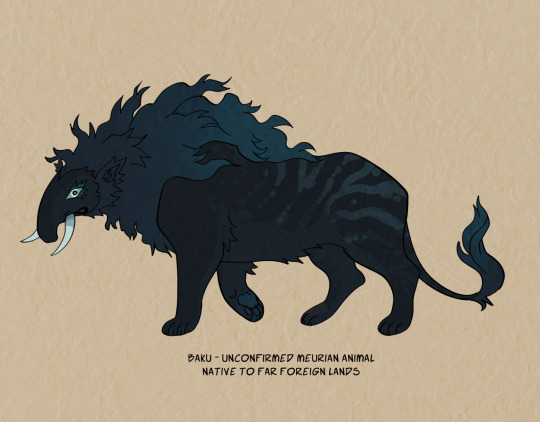

Hares, as you may already know if you've been following my better half @broncoburro or @forevergoldgame (if you're following neither, you're missing huge amounts of context for the setting!), are nothing like the hares of the real world. They are massive leporids from Northern Vestur and one of the few meurian animals remaining after a historic event known as the Great Hunt where humans wiped out most of the planet's remaining meurian species in order to harvest their meur for relics about 350~ish years ago. They are obligate carnivores and known to hunt humans when the opportunity arises.
The baku is a large, lumbering omnivore with a similar ecological niche somewhere between a panda and a regular bear. They're a rare species, endemic to a single far-flung region of the world, having only just barely escaped extinction. See, while the Great Hunt was headed and funded by the Tri-Kingdom, its reach spanned the entire known world - but the further from Vestur it travelled, the less discriminatory the hunts became. The local peoples who were paid to hunt on the Tri-Kingdom's behalf had little idea of what meur was and what meurian animals were actually useful, leading to mass to mass culling of "useless" meur-touched animals like the baku, whose unusual sleep-inducing abilities cannot be wielded by humans. Regardless of their uselessness, the damage had been done to the species, and only the mundane offshoot survives - though rumors persist about meurian baku.
Sphinxes are scavengers that can be found across the deserts and savannas of the mainland. Unlike their meurian cousin, the manticore, they never evolved meurian flame breath, and their 'stinger' is no more than a vestigial sickle buried beneath the fur of their flowing tails. Instead, they specialized further into human mimicry, using their ability to copy human speech to hunt domesticated animals, naive children, and drunkards.
Now you might be thinking: "why would a teenage girl want to own any of these as pets? None of these sound like animals that should be pets." Well, first off: you'd be hard pressed to find a young girl that doesn't want a wolf or a tiger as a pet, that's just how they are, c'mon.
Second, there are three primary reasons Rhea thinks this is a more realistic idea than it is:
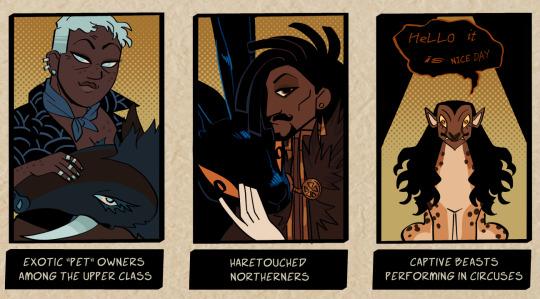
Exotic "pet" owners among the upper class: While exotic pet ownership isn't big in Vestur as a whole, it has a notable presence among the Southern upper class, both noble and common. Rhea is the duchess of the Southern Kingdom so she is well aware of every instance of somebody paying excessive amounts of guilder to import something they shouldn't and stick it in their courtyard.
As I've mentioned before, this is a sin Ancha is guilty of, having gotten swept up in a past "teacup baku" craze/scam some 4 decades ago. Unlike her peers, however, she kept her baku, Fig, even after he outgrew his alleged "adult size" of 1'9" at the withers. Others culled theirs once they became large enough to cause mass property damage. Ancha knows Fig is a massive, terrifying wild animal and does not recommend anyone repeat her mistake, but being raised in captivity he cannot be returned to the wild and so she's committed to caring for him for as long of his estimated 70~ish year lifespan that she's here for.
Haretouched Northerners: The "haretouched" is a strange phenomenon that exists in the North. Now, we haven't posted a formal explanation of what exactly being haretouched means yet - I'll save that explanation for Dan to write at a later date. In the meantime, to very briefly summarize what it means: occasionally, a hare will bond with a specific human. Those who have bonded to a hare are said to be "haretouched" - or more bluntly, cursed. The haretouched are treated as pariahs by broader society, though they are begrudgingly tolerated in the North itself and destigmatized by Northern nomad clans.
While Northern nobility has done its best to keep the haretouched out of their bloodlines (save for the Lord of the Nomads, who is seldom acknolwedged, much less counted), occasionally a fluke will occur regardless and you end up with someone like Quincy or Lamonte.
Rhea, of course, is just a Southern bystander who thinks the idea of having a murder-bunny for a friend would kick ass.
Captive beasts performing in circuses: Self-explanatory. Sphinxes especially are a popular choice for exploitative entertainment because of their mimicry abilities, and are often trained to have "conversations" or "sing."
#verse: forever gold#oc: rhea#answered ask#character ask#oc askblog#fantasy setting#fantasy animal#sphinx#baku#creature design#monster lore#creature concept#oc: ancha#sc: fig#oc: lamonte#sc: tulip
48 notes
·
View notes
Text

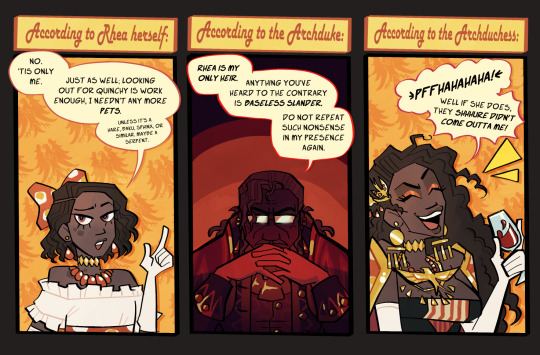
On the books, no. Elsewhere... maybe? Despite her parents' mutual infidelity being an open secret in the Southern court, no bastard half-siblings have made themselves known.
56 notes
·
View notes
Text
I said it before but I'll say it again: your shapes man... YOUR SHAPES!! (And Lamonte's punchable little smile)


Some quicky late birthday gift draws for @lsdoiphin and @broncoburro of two of their @forevergoldgame guys Lamonte and Quincy!
69 notes
·
View notes
Text
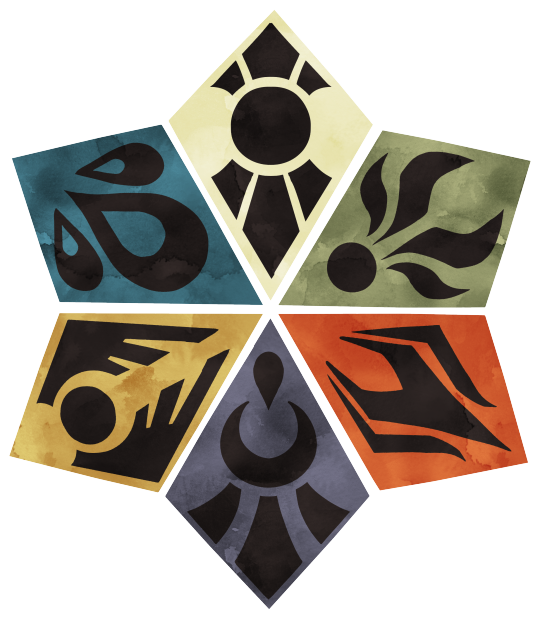
MEUR TYPES: A PRIMER
Meur (or magic) is a natural force in Vestur. Since the invention of the Andimeur Synthesizer (a device that converts it into a form usable by man), Vestur’s aristocracy has continually found new uses for it. From homes heated by red meur to nutritionally dense food aided by green meur, the Tri-Kingdom has gained the distinction of most scientifically advanced country in the known world.
Children in Vestur sometimes play a clapping game that goes as such:
“Green’s for the beans on my supper plate,
Blue’s for the clean water enjoyed while I ate,
Red warms my toes when there’s snow on the ground,
Yellow’s how a Southern fellow steers his ship around,
And if he crashes it upon the shore
The Architect alone will decide his score:
Black, White, Black, White, Black, White, Black
If the man is slack, it’s the work of Black
If he avoids the light--
Then thank goodness, it’s White!”
Like all good children’s songs, it ends in giggles about dying a horrible death. But it effectively teaches every child in the Tri-Kingdom about what each of the six meur types, or colors are, and their most common use cases.
Green meur affects the botanical world. While plants cannot be summoned into existence through green meur alone, it can be used to grow plants in conditions that shouldn’t be able to foster them. It may also alter their growth trajectory or physical properties. Almost none the of the plants grown in the Northern Kingdom could survive the nutrient-poor, hard soil without green meur. Specializing in green meur may sound tame or perhaps boring at first (and green meur users are stereotyped as such), but bring domesticated thorny vine seeds onto the battlefield and a competent green meur user will be sending barbed tendrils through an enemy’s torso in seconds.
Blue meur pertains to water. The ability to command water’s flow has several use cases in itself: powering water wheels, irrigation for agriculture, maintenance of sewerways. But this meur type takes on new complexities when you consider water’s other states. Ice can be easily weaponized, and some innovative meur scientists have been doing research into engines powered by steam. Even more mysterious, it seems water’s omnipresence on earth has lent blue meur some properties related to the flow of time. There’s more to blue meur than is currently understood.
Red meur is pure energy in the form of heat. When wielded by man, It’s most commonly seen as fire. Heat is useful for everything from keeping a forge running to warming air in houses. Red meur is (sadly) not a free energy buffet though, and has some major downsides: it’s inherently tiring and energy-intensive on the user. In addition, fine control is difficult. Red meur users have something of a reputation for being none too bright, but many of said users would rebuff this with “easy to use, difficult to master”.
Yellow meur affects air. It’s mainly used to influence wind direction and speed, leading to some of the fastest trade ships in the known world. As a result, yellow meur is an eclectic choice for anyone to specialize in besides Southerners. The current use cases are narrow... but this might be more due to lack of interest in the field than anything else. Who knows, perhaps some sort of yellow meur related discovery is around the corner....?
Green, blue, red, and yellow are the standard meur colors. Upwards of 95% of Vestur's nobility have their specialty in these four. There are two less common meur types though, and they have a lot of mythologizing around them, as well as being less understood.
White meur is usually described by laymen as “the healing one”. Say that to any white practitioner and watch him start pulling his hair out in frustration and screeching through gritted teeth, “its so much deeper than that!”. Those who use white meur must, in addition to finishing standard meur education at Vestur Royal Military Academy, score well on the White College Aptitude Test and be accepted to the College of Divine Healing, where they’ll learn about the human body, pathology, and advanced white meur for an additional two years. Only then can one be certified as a white practitioner. Without knowing what you’re putting back into place and why, it’s horrendously easy to do more harm than good when mending the human body.
All this said, white meur can’t do miracle work. Wound closure or bone refusing is one thing – regrowing a whole arm or bringing someone back from the dead is strictly in the realm of fantasy.
Black meur inflicts death, plain and simple. It is unilaterally outlawed. Its only practical use is in combat, but black meur is considered a dishonorable way to inflict suffering. Any of the standard colors can just as easily be used to kill. Only one nobleman in all of Vestur is registered as a black meur user, and the designation was given as a soft way to say, “you are disallowed from wielding meur of any color”. Though... he really is quite talented at it, as circumstance will soon reveal.
And those are the meur colors! Every noble child in Vestur goes to VRMA and gets educated on the principles of wielding each, but as a graduated nobleman in the service of your community, a person may only specialize in one.
Any given two blue meur users likely have their in very different applications: one might maintain a city’s sewerways, and another might work to provide potable water in an area where there is none. There is a lot of variation and opportunity within any given color.
(The little emblems for the meur types, as with all of Forever Gold's more graphic design-y work, were done by LSDolphin!)
52 notes
·
View notes
Text




Lucas was a talented truant during their school days. Quincy, more a middling performance stickler to the rules. They grew on each other over time. (Or more importantly, Quincy is of the few capable of tolerating Lucas's whims.)
I must save greater specifics since they are addressed in the game, BUT... it boils down to "they were both unpopular children who happened to be in the same place at the same time".
99 notes
·
View notes
Text

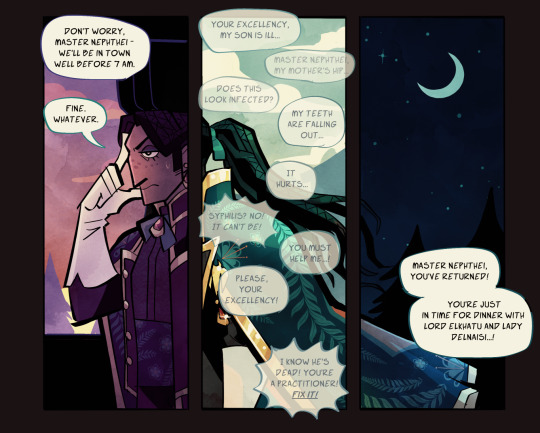
You are absolutely correct, his schedule is excruciatingly planned. Some of it is self-inflicted, some of it is just the result of being heir to a lordship.
He started living an extremely scheduled life while studying for his WCAT (White College Admission Test) and maintained it through his studies at the College of Divine Healing. Once he graduated, he didn't know what to do with the "extra time," so he took on more work to compensate.
On an average day, he is up and dressed long before the servants come to wake him. His days are busy, and so the morning is the only time he gets peace and quiet to himself. Even so, he'll often run out of time and skip breakfast entirely, spending half his day extra sour because he's hungry. As you can imagine, this puts him in a great mood for working with the sick and injured.
Depending on his agenda, his white practitioner duties might take him anywhere in the Boreal South or even adjacent lordships, so of course he has to factor travel time into any plans he makes. On a good day, he's working within his city - the Boreal South capital, Polaris. On a bad day, he could be waking up hours earlier and spending half the day in a carriage, itching because he knows his work day technically hasn't begun.
He'll begin work whenever he reaches his destination. There is often a line formed already, especially if he has traveled far to a populated area. He'll mend bones and tend wounds until around noon when he stops for a quick meal. Then it's back to work...
On the rare occasion that he manages to make it through his duties early, he will steal that time for himself. If he's out of town, he'll sight see. If he's in Polaris, he'll hide in the back room of the clinic (so that no one realizes he's "free" and bothers him) and indulge in some reading or letter writing.
By the time he returns to the Nephthei estate, it's often late. If he's lucky, he's so late that he's missed whatever guests his mother has dragged in for the evening and can avoid being forced to make cold and awkward conversation while hungry and exhausted. Sadly, Lady Nephthei loves hosting and will keep her guests late into the night, so the odds are stacked against him on this one.
As tight as his schedule is, he does make room for leisure time... within very strict time frames.

The few people he's close to find it quite frustrating.
22 notes
·
View notes
Text


The general consensus among those who know him is "yes."
(I haven't introduced him before so: the eloquent gentleman defending Kaitos's intelligence here is his favoritest and wisest uncle, Kalas. He lives up in the South's Midland enclave, hence the differing fashion. )
#oc ask#character ask#verse: forever gold#oc: kaitos#oc: kalas#answered ask#comic#I can name my characters in a way that makes me laugh if I want. you gonna stop me?
29 notes
·
View notes
Text
SEEKING ASKS

Dan's taking some Forever Gold asks over on her artblog and that made me remember I ALSO want some... send ME some asks about Forever Gold worldbuilding/characters?
Pretty much any character that was introduced first on my blog/through my art is my jurisdiction, but here's a recap so you don't have to go double checking: Kaitos, Rhea, Ancha, Itaja, Lamonte, Cathy, and some other terrible beings not yet introduced.
I also did most of the worldbuilding for the Southern Kingdom and Vestur's religions so I'm cool talking about those topics.
14 notes
·
View notes
Text
Oops! I need to fund my extravagant hobby of "living."
13 notes
·
View notes
Text
Is there a real cause for like, ghost messages? My inbox has been trying to tell me I have 3 asks and I just got a notification for a new one but when I go to look there are still only 2.
8 notes
·
View notes